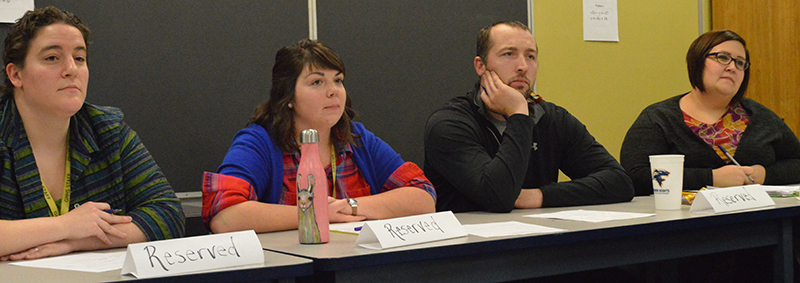Though some may think it’s crummy, 10th-graders Madalyn Austin and Rebekah Hoyle said The Snacky Sleeper is the perfect lazy-evening, popcorn-munching luxury: a “comfortable, supportive memory foam pillow” with a pouch for snacks.
“The Snacky Sleeper keeps your snacks in great, undamaged condition,” said Madalyn as the duo delivered a slideshow presentation including different views of the product they developed.
“Our pillow is easy to use, it saves time. It’s not only good for kids and teenagers, but it’s also helpful and comfortable, and it’s safe for sleeping,” Rebekah said.
But did their product really have teeth? That would be up to the Sharks to decide. The Sharks, a panel of Godwin Heights High School educators who took on the persona of business-savvy millionaires, evaluated the pillow, circling in closely on math the students used to estimate potential profit.
They did the same for products like Toasty Toes, a battery operated toe warmer; The Boomer, a Bluetooth-enhanced cell-phone case; PakTele, a backpack-phone combination that works to contact 911 in an emergency; and the Diskinizer, a video-game organizer that uses a robotic arm.

Let’s Talk Numbers
Students used math to develop their pitches to the Sharks, seated in front of them in the style of TV show “Shark Tank.”
Algebra 2 teacher James Rex started the game last year to provide students a lesson in business, while learning the math involved in bringing a product to market. Students developed the products, brainstormed materials, researched all costs and came up with estimates.
“Sometimes they come up with things that are super-creative, and sometimes they come up with things that are super-unrealistic,” Rex said. “You want to encourage that creative element of it and give them the freedom to explore their ideas and think through it, but also to ground them in the math and the feasibility of some of those things.”
During presentations, Rex based his offers on the math. “I feel like I trick them into talking about their numbers,” he said. “That’s where I get the bang for my buck in terms of their learning. They are up there talking about math in a high-pressure situation. I try to keep it light, relaxed and fun for them.”

Snacky Sleeper: Sink or Swim?
Showing their work through algebraic equations and graphs, Madalyn and Rebecca calculated each Snacky Sleeper would cost $15 to produce; monthly rent for manufacturing space would cost $30,000; and monthly wages for employees at $10 per hour for a 40-hour week would cost $16,000. By selling each pillow at $25 they would profit $10 per pillow.
“When we break even it will be at 5,500 pillows sold (per month),” Rebekah said.
Their request for the Sharks: $60,000 in investment for 40 percent of the company.
While Principal Chad Conklin said he has an aversion to food in his bed and would not invest for that reason, Rex took a bite at the offer, though he questioned if the company could sell enough pillows to make a profit.
“I see potential. I see this as being something millennials would use,” he said. “My offer is $80,000 for 50 percent of the company.”
Math coach Molly Mosketti also made an offer: $60,000 for 45 percent of the company. “I’m thinking this might be a covert way for parents to enjoy a snack,” she said.
Students said the project allowed them to learn how to do calculations in a fun way and have a real-life experience in pitching a product.
“I liked debating with the sharks,” said Jalisa Lopez-Longoria, who helped pitch PakTele. “I like how we got to pick our product and find our own numbers to figure out the prices we want to use.”
CONNECT










